Nicole schreibt...
South American Cruise |
 |
Argentina

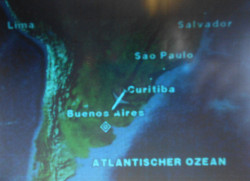 After liking the first cruise to the Canary Islands quite a lot, I thought it might be a good idea to use this mode of transport for more explorations and was thrilled to find one that would take me to exciting South American places I had wanted to see for a long time, especially Buenos Aires and Rio de Janeiro. It also proved a perfect escape into summer when it was cold and grey in Germany. While AIDA offered the cruise itself for a sensational 699 Euro (two weeks all-inclusive!) their "travel package" was ludicrously overpriced at 1750 Euro per person, so I just knew I could do better.
After liking the first cruise to the Canary Islands quite a lot, I thought it might be a good idea to use this mode of transport for more explorations and was thrilled to find one that would take me to exciting South American places I had wanted to see for a long time, especially Buenos Aires and Rio de Janeiro. It also proved a perfect escape into summer when it was cold and grey in Germany. While AIDA offered the cruise itself for a sensational 699 Euro (two weeks all-inclusive!) their "travel package" was ludicrously overpriced at 1750 Euro per person, so I just knew I could do better.Could I? You bet. We saved about 500 Euro per person and didn't only have direct flights on Lufthansa, I was also able to book seats in what I think is the best row in Economy - directly behind the partition, so nobody slams his seat into your face and you can stretch your legs all you like. Things got even better when it was finally time to board our flight from Frankfurt to Buenos Aires Ezeiza: The guy who had the third seat couldn't bear to be parted from his chick and since there were a few spare seats, he went to sit elsewhere with her, so it was just us. I had been worried about a 14 hour flight (yes, fourteen hours!), but it turned out to be one of the nicest long distance flights I ever had. I first slept a few hours in my seat, then when everything was dark and the crew disappeared, I stretched out on the floor before our row, where I could lie down properly and sleep another few hours. Best.Sleep.Ever.On.A.Plane.
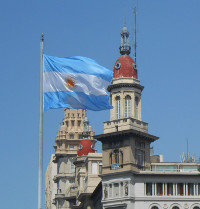 So I was quite rested, awake and most importantly not at all head-achey when we arrived in Buenos Aires at 8am Argentinian time. Everything there went smoothly too without AIDA holding our hands - getting stamped into the country, clearing customs, booking a taxi that delivered us smoothly to the Passenger Terminal at the port of Buenos Aires. And since we had made it way ahead of the stampede (All those who had been on the same flight but relied on the AIDA transfer buses) we were among the first in the queue whe check-in opened at 10am. So we went aboard quickly and with very little waiting time - but since we couldn't enter the cabin yet (or access our luggage) we could just dump cabin luggage in the theatre. NOT fun to remain in my "flight clothes", especially in +30C degrees heat, but nothing to be done about it. I sure as hell wasn't going to waste hours on the ship just to wait for my stuff.
So I was quite rested, awake and most importantly not at all head-achey when we arrived in Buenos Aires at 8am Argentinian time. Everything there went smoothly too without AIDA holding our hands - getting stamped into the country, clearing customs, booking a taxi that delivered us smoothly to the Passenger Terminal at the port of Buenos Aires. And since we had made it way ahead of the stampede (All those who had been on the same flight but relied on the AIDA transfer buses) we were among the first in the queue whe check-in opened at 10am. So we went aboard quickly and with very little waiting time - but since we couldn't enter the cabin yet (or access our luggage) we could just dump cabin luggage in the theatre. NOT fun to remain in my "flight clothes", especially in +30C degrees heat, but nothing to be done about it. I sure as hell wasn't going to waste hours on the ship just to wait for my stuff.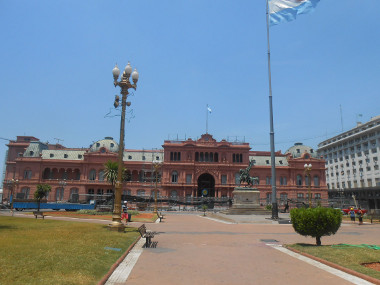 We grabbed a quick early lunch at 11.00, then left the ship once more to walk into town - not all that much of a walk after all - and firs strolled down Calle Florida, the main shopping drag, where christmas shopping seemed really odd in the heat, then finally to Plaza de Mayo with the Casa Rosada, Argentina's (very pink indeed) presidential palace which every musical lover knows. It was one of these kick me, I must be dreaming moments to stand in front of the real building. My mind was still struggling to grasp the fact that I was actually in Argentina, South America.
We grabbed a quick early lunch at 11.00, then left the ship once more to walk into town - not all that much of a walk after all - and firs strolled down Calle Florida, the main shopping drag, where christmas shopping seemed really odd in the heat, then finally to Plaza de Mayo with the Casa Rosada, Argentina's (very pink indeed) presidential palace which every musical lover knows. It was one of these kick me, I must be dreaming moments to stand in front of the real building. My mind was still struggling to grasp the fact that I was actually in Argentina, South America. And Buenos Aires, I think, looks very much like the slightly shoddy worn down sister of Barcelona with its gorgeous 19th century buildings and leafy avenidas. Another stop on the gorgeous Plaza de Mayo was the Cathedral of Buenos Aires, which some months ago, I hadn't much cared about, but which now took on a different meaning as the "home" of the new Pope Francis, who I admit, I really really like. Much like him, the cathedral doesn't look like much from outside but is really lovely inside, too.
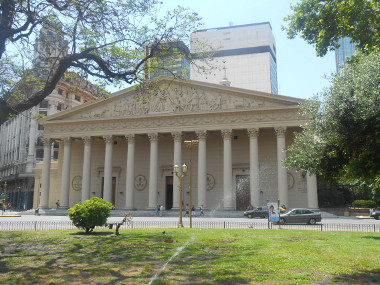 |
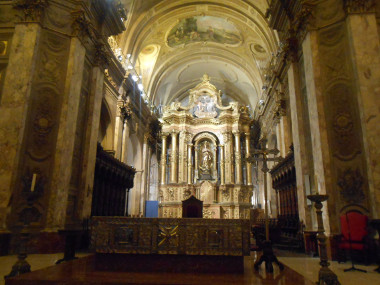 |
We walked up Avenida de Mayo and had a pit stop at the legendary Cafe Tortoni, a beautiful Belle Epoque coffeehouse that has been hosting tango shows for a century by now, before reaching the Capitol Building of the Argentinian government.
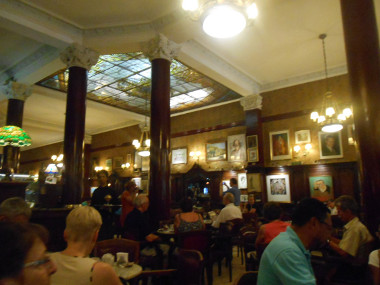 |
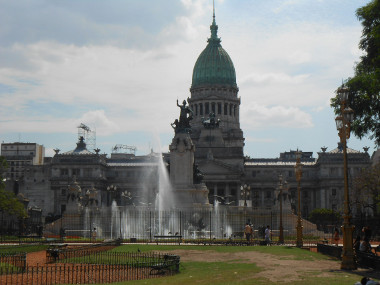 |
Finally we reached the huge Avenida 9 Julio, which you've all seen on a photo already with its gadzillion lanes and the gleaming white Obelisco - though the middle section have been converted to bus lanes, so it doesn't feel all that intimidating and just like a really nice large boulevard lined by hotels, restaurants and shops. It was also a good place to hail a cab and return to the ship for the rest of the day.
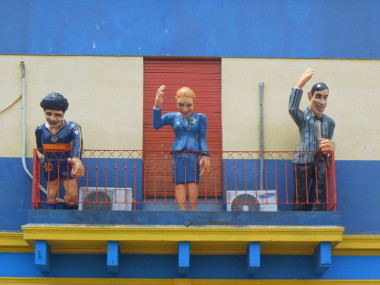 The full day began slowly, with a late breakfast before taking a cab to the Caminito, the most famous street of the whole city. For when travelogues on television make it appear as if half of Buenos Aires consists of gorgeous old-fashioned houses in bright flashy colours, they really mean just a short triangle of streets in La Boca, a rather scruffy working-class neighbourhood by the river (probably best known for their football team Boca Juniors, where legendary Diego Maradona started his career), that was transformed by local artist Benito Quinquela Martin in the 60s.
The full day began slowly, with a late breakfast before taking a cab to the Caminito, the most famous street of the whole city. For when travelogues on television make it appear as if half of Buenos Aires consists of gorgeous old-fashioned houses in bright flashy colours, they really mean just a short triangle of streets in La Boca, a rather scruffy working-class neighbourhood by the river (probably best known for their football team Boca Juniors, where legendary Diego Maradona started his career), that was transformed by local artist Benito Quinquela Martin in the 60s.The regular main street leading to La Boca was closed off because of a city run, so the cab driver had to take a detour along the river past some rather iffy slums with dogs actually chasing the cab for a bit and barking at it. Spooky and yet somewhat interesting to see just how some people live in this big city. The Caminito itself was super-touristy of course but nonetheless very pretty to see and definitely worth the cab ride out to La Boca. Can you identify the three most famous Argentinians ever?
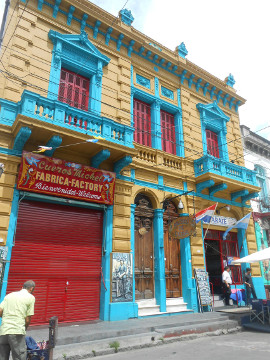
| 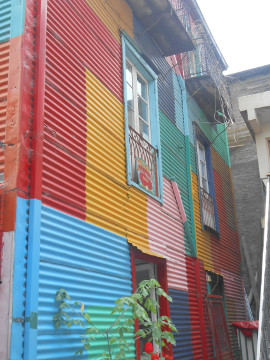 |
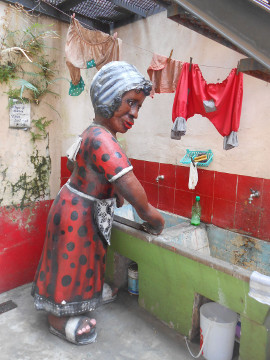 |
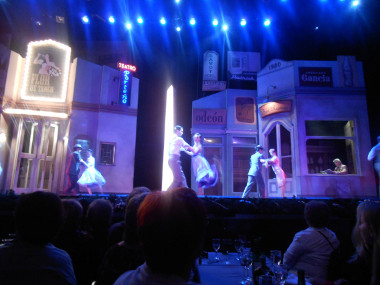 After a stroll around the area and a light lunch we took another cab up to San Telmo and the Plaza Dorrego where the Sunday flea market was in full swing and extended along the main drag all the way to Plaza de Mayo. From there it was finally back to the ship for some rest before heading out once more in the evening do that one tourist must-do in Buenos Aires, the tango show. Ours (booked through the cruise) was at Tango Porteno on Avenida 9 de Julio and began with a nice typically Argentinian meal (translation: The mother of all steaks and delicious it was too!) before the 90 minute tango show, which was pretty damn good and I just loved the whole atmosphere in the slighty run-down Art Deco theatre (apparently once a huge cinema) and there were still some moments of fuck me, I can?t believe I'm in actual Buenos Aires!.
After a stroll around the area and a light lunch we took another cab up to San Telmo and the Plaza Dorrego where the Sunday flea market was in full swing and extended along the main drag all the way to Plaza de Mayo. From there it was finally back to the ship for some rest before heading out once more in the evening do that one tourist must-do in Buenos Aires, the tango show. Ours (booked through the cruise) was at Tango Porteno on Avenida 9 de Julio and began with a nice typically Argentinian meal (translation: The mother of all steaks and delicious it was too!) before the 90 minute tango show, which was pretty damn good and I just loved the whole atmosphere in the slighty run-down Art Deco theatre (apparently once a huge cinema) and there were still some moments of fuck me, I can?t believe I'm in actual Buenos Aires!.We still had another morning in the city, so we returned to the main shopping drag Calle Florida mostly to look for a nice handbag - Argentina's cows don't only end up as delicious steaks but also in low-priced high-quality leatherware. By noon it was time to say goodbye to the city to return to the ship for the safety exercise and finally departing. Buenos Aires is definitely worth visiting for a couple days in combination with something else - a cruise, heading on to Patagonia or whatever but I think three days are pretty much enough for the city.
Uruguay

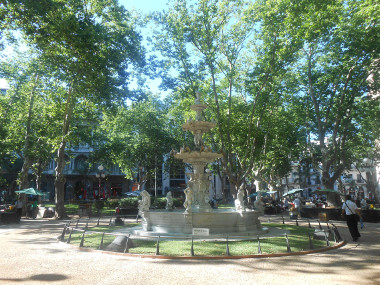
The next sunrise found us in Uruguay and its capital Montevideo, a town I admittedly knew nothing about. We strolled through the Ciudad Vieja, the colonial old town with its pretty small houses and leafy squares first and on to Plaza Indepencia, where the "new" town begins, marked by the old gate of the fortress (Ciudadela) and the huge monument to Uruguay's national hero, General Artigas, whose ashes are kept in a mausoleum underneath his statue.
From here the Avenida 18 de julio expands eastwards, opening up the "new city" of Montevideo with some gorgeous Art Deco buildings like the landmark Palacio Salvo (in the middle) and the Cafe Montevideo (right) still standing between quite a lot of ugly modern concrete.
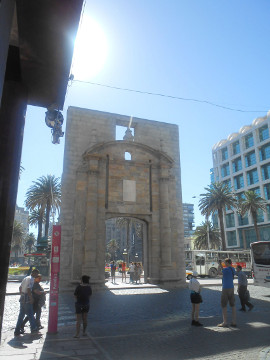
| 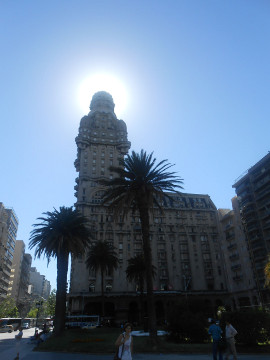 |
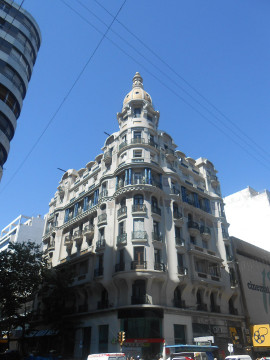 |
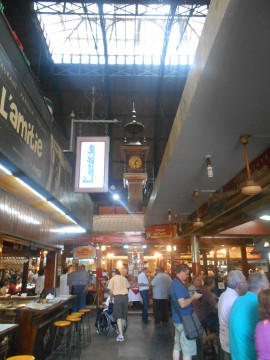 We followed the Avenida to the ugly Palacio Municipal, an eyesore if I ever saw one, but with elevators going up to a nice mirador on 22nd floor at the back of the building. We didn't just get a nice view all over Montevideo this way but also a fascinating insight into South American bureaucracy, seeing the poor citizens stand in endless queues to see some official. We trudged back to the Ciudad Vieja for a fuel stop with Uruguayan chivitos (something like a burger) with fries in leafy lovely Plaza Constitucion, then returned to the port area for one last stop in the Mercado del Puerto, which was once a regular fish/groceries market by the harbour and has been transformed into a rather cool place with bars, restaurants and little shops, including the famous Roldos bar with its "medio y medio" drink that's half white wine and half champagne - a very nice way to finish the walking tour of Montevideo before returning to the ship for a few hours on the sun deck.
We followed the Avenida to the ugly Palacio Municipal, an eyesore if I ever saw one, but with elevators going up to a nice mirador on 22nd floor at the back of the building. We didn't just get a nice view all over Montevideo this way but also a fascinating insight into South American bureaucracy, seeing the poor citizens stand in endless queues to see some official. We trudged back to the Ciudad Vieja for a fuel stop with Uruguayan chivitos (something like a burger) with fries in leafy lovely Plaza Constitucion, then returned to the port area for one last stop in the Mercado del Puerto, which was once a regular fish/groceries market by the harbour and has been transformed into a rather cool place with bars, restaurants and little shops, including the famous Roldos bar with its "medio y medio" drink that's half white wine and half champagne - a very nice way to finish the walking tour of Montevideo before returning to the ship for a few hours on the sun deck.Next stop was the famous seaside resort of Punta del Este, sometimes dubbed South America's Miami or Monaco (depending on your origin) where the rich and famous of Argentina and Uruguay congregate in palm-shaded villas or high-rise condos. Brava Beach with the famous "mano" (the hand) by Chilean artist Mario Irarrazabal was definitely to die for, but the whole town was quite lovely.
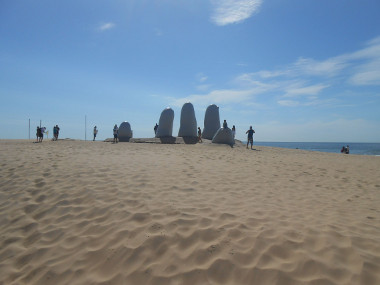 |
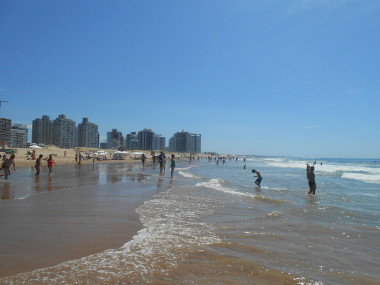 |
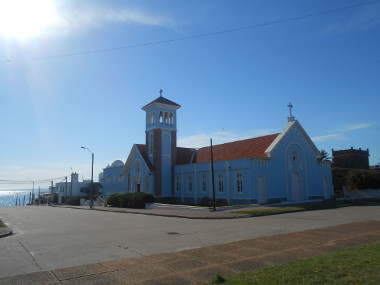 |
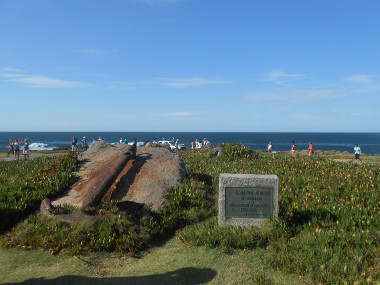 |
There was also a pretty church to see and the Plazoleta Gran Bretana at the southern-most tip of the peninsula where the Atlantic Ocean meets the Rio de la Plata delta and where the anchor of a British warship that sank here in 1939 is displayed. We lingered in Punta del Esta till the late afternoon when we were forced back onto the ship - with two full days at sea ahead while the AIDAcara steamed north towards Brazil.
Brazil

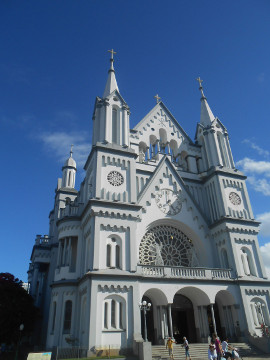 The less said about these days, the better. Although at least the sun deck wasn't too crowded and the pool actually big enough and not too crowded to actually swim in. I was sooo ready to bolt off the ship on the third morning when we'd dock at Itajai, so my dismay was the greater for hearing that we couldn't dock until 2pm in the afternoon since there was some big freighter that needed the one harbour channel to get out of the port.
The less said about these days, the better. Although at least the sun deck wasn't too crowded and the pool actually big enough and not too crowded to actually swim in. I was sooo ready to bolt off the ship on the third morning when we'd dock at Itajai, so my dismay was the greater for hearing that we couldn't dock until 2pm in the afternoon since there was some big freighter that needed the one harbour channel to get out of the port. So the AIDA Cara just hung around in front of the coast until we saw the almighty freighter pass by and did dock just after noon. Conveniently they opened lunch a bit early and we could grab a bite, then leave the ship. After the none too grand experience with the organized tour on Lanzarote we had decided to handle this kind of thing alone on this cruise and so we headed for the taxi stands to check about a tour to Blumenau, the Black Forest in the tropics. As I had hoped, we could "book" a taxi to take us there, wait for us about two hours, then take us back to Itajai - all of that for 300 Reais (roughly 90 Euro) whereas the organized tour (with an obnoxious tour group to boot) had cost 111 Euro for two - go figure.
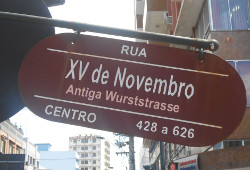 On the 60 minute drive to Blumenau our chatty chirpy taxi driver Pedro taught us some Portuguese straightaway and was generally just has I had envisioned the Brazilians to be. Blumenau is nowadays famous for the second-biggest Oktoberfest in the world (right after Munich's original) and the town itself was founded in mid-19th century by a German group of emigrants around a certain Dr Blumenau who took a boat up the Rio Itajai and thought "hey this looks nice, let's stay here" So Blumenau has plenty of very German-looking houses and a general feeling of a stuffy small German town transplanted to the hot tropics with all the signs in Portuguese.
On the 60 minute drive to Blumenau our chatty chirpy taxi driver Pedro taught us some Portuguese straightaway and was generally just has I had envisioned the Brazilians to be. Blumenau is nowadays famous for the second-biggest Oktoberfest in the world (right after Munich's original) and the town itself was founded in mid-19th century by a German group of emigrants around a certain Dr Blumenau who took a boat up the Rio Itajai and thought "hey this looks nice, let's stay here" So Blumenau has plenty of very German-looking houses and a general feeling of a stuffy small German town transplanted to the hot tropics with all the signs in Portuguese.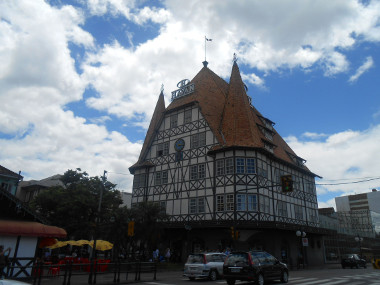 |
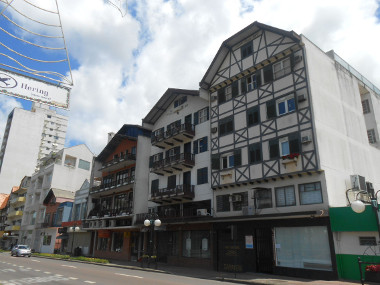 |
The highlight of the trip was a visit to the Vila Germanica though, the venue of the Oktoberfest, in front of which a fake Disneyland-Germany of sorts has sprung up, offering a christmas village just now - including fake snow for a winter wonderland on which the tropical sun was burning down! It's just something you need to see to believe.
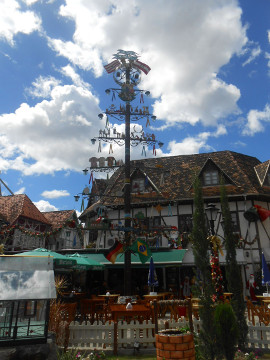
| 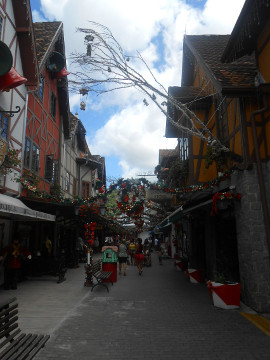 |
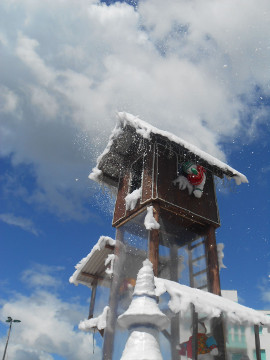 |
Finally Pedro took us back to Itajai with one last stop at the lovely cathedral (the one above) before dropping us off at the harbour. We strolled up and down the pedestrian shopping street, where christmas music was blaring everywhere as people rushed about for their last christmas shopping in tropical heat, then returned to the cruise terminal to take advantage of their free (somewhat decent) wifi, before returning onto the ship.
 Of course the high had to be followed by a low. Paranagua, the next port further up the Brazilian coast, was the one place where I hadn't been sure what to do - Go all the way to Curitiba? Visit historic Morretes? Take a boat to the beautiful Ilha do Mel ("Honey Island")? Do sod all?
Of course the high had to be followed by a low. Paranagua, the next port further up the Brazilian coast, was the one place where I hadn't been sure what to do - Go all the way to Curitiba? Visit historic Morretes? Take a boat to the beautiful Ilha do Mel ("Honey Island")? Do sod all?In the end the weather decided - it was pissing it down that morning, so we only took a shuttle bus into the city of Paranagua itself and even "city" is a bit much for what was really just a small place along the Rio Itiberé - probably nice to stroll around the historical little streets and pretty colorful colonial buildings, but NOT in iffy drizzle that sometimes turned into downpours. So we ended up buying umbrellas, trudged around the soggy streets, peeked into churches and had a coffee break at the lovely and lively Mercado do Cafe, where once big bags filled with coffee beans were traded.
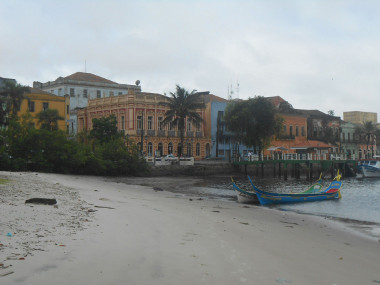 |
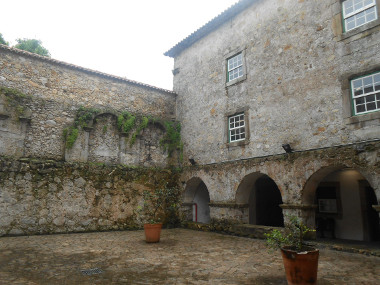 |
We finally took a look at the little local museum which is housed in the old Jesuit monastery that was the start of the settlement in 17th century and was worth seeing for the building alone, before fleeing back to the comfy warmth of the ship's spa. Not Paranagua's fault of course and boy was I glad we hadn't spent money on the horrifically overpriced excursions (35 Euro per person for a guided walk through the village! 125 Euro for a trip to the Ilha do Mel!!)
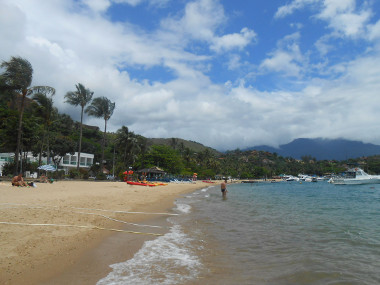 The weather shaped up again and so did the destination, the absolutely lovely Ilhabela (Beautiful Island), a large island off the Paulistano coast covered by dense rainforest that once proved perfect shelter for the many pirates that lurked along the coast. Even today there are just three settlements on the northern coast, running into each other by now, lined by beaches, pousadas, little restaurants and a cluster of nice shops in Vila, the "old town". Ilhabela is now a favorite weekend getaway for the folks from Sao Paulo, which also meant for once mingling with native holidaying people and feeling in a true vacation spot among chatty families and other locals.
The weather shaped up again and so did the destination, the absolutely lovely Ilhabela (Beautiful Island), a large island off the Paulistano coast covered by dense rainforest that once proved perfect shelter for the many pirates that lurked along the coast. Even today there are just three settlements on the northern coast, running into each other by now, lined by beaches, pousadas, little restaurants and a cluster of nice shops in Vila, the "old town". Ilhabela is now a favorite weekend getaway for the folks from Sao Paulo, which also meant for once mingling with native holidaying people and feeling in a true vacation spot among chatty families and other locals. We walked along the beach from Vila to the far end of the settlement before finally flopping into the white sand for a while, but alas it clouded over by mid-afternoon. So after one last stop at a nice outdoor bar with my first (and only) caipirinha in Brazil and the supposedly super-healthy Açai berries as an iced smoothie from a little stall, it was back to the ship.
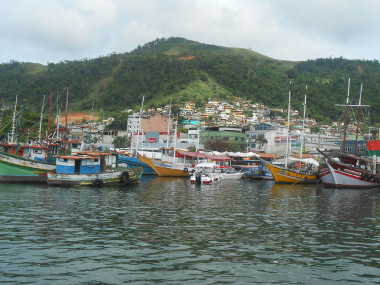 On 24th December I woke up to find that christmas had thrown up all over the ship with decorations in the restaurants, christmas trees in the hallways and waiters wearing Santa hats (!). Port for the day was Angra dos Reis, where I had actually booked an organized trip to get to the Ilha Grande, another of those pirate haunts from long ago that later achieved some infamy for housing a leper colony which was later turned into a political prison.
On 24th December I woke up to find that christmas had thrown up all over the ship with decorations in the restaurants, christmas trees in the hallways and waiters wearing Santa hats (!). Port for the day was Angra dos Reis, where I had actually booked an organized trip to get to the Ilha Grande, another of those pirate haunts from long ago that later achieved some infamy for housing a leper colony which was later turned into a political prison. Even today Ilha Grande is very little developed with a gorgeous to die for little main town called Abraão where no cars are allowed at all and the police roams around on a beach buggy. I had been worried to get stuck on the island with no ferry back to Angra dos Reis in time for the ship's departure, so we became sheeple for the day, trudging after a local guide with the very Brazilian name of Hans, along a hiking trail to the old hospital/prison, stopped at a lovely little beach nearby, saw a nice waterfall and the aqueduct that still supplies Abraão with mountain water.
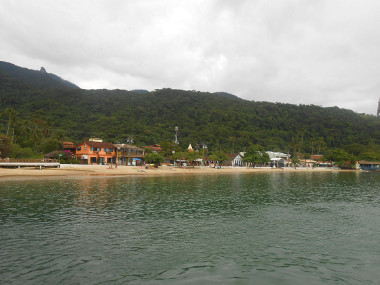 |
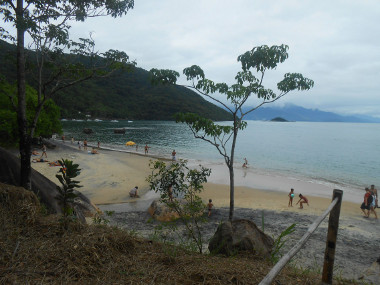 |
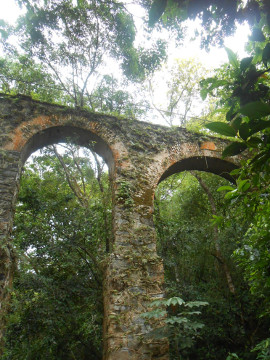
| 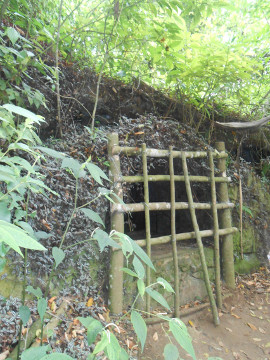 |
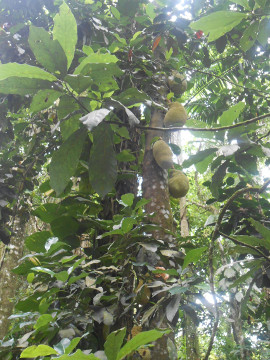 |
After a lunch stop, it was time to board the schoner again and sail back to Angra dos Reis. By then it was raining again, so instead of another walk around the town we returned to the AIDAcara for a few hours of warming up at the spa.
Christmas in the tropics just feels overall odd and despite a christmassy dinner, it was hard to feel in the mood. We had cocktails after dinner and watched a recorded christmas message by some Dominican Padre at the theatre, waiting for the official christmas show, a nice mix of traditional German and modern American christmas tunes. Though it was a Filipino guy who brought the house down, singing a traditional Tagalog song while behind him on a screen they showed pictures of him at home in the Philippines with his wife and little daughter, bringing home to the well-fed lazy holidaymakers, that all these helpful invisible ghosts around the ship are human beings with their own lives in a far away country. I think there wasn't a dry eye in the house when he finished. Finally the captain himself appeared on stage, along with a huge bunch of crew members for a rousing finale of Silent Night in several languages. The whole thing was really well done, gotta say that. Another cocktail followed and then christmas eve was done for me.
 Christmas Day on the beach - that was a new one for me too. The beach in question being in the resort town of Buzios not far from Rio de Janeiro. Brigitte Bardot is credited for putting the place on the map when she came here with her Brazilian lover ages ago and the Rio hoi-polloi was quick to follow. The tourists have kept coming and they put a statue of Bardot up to thank her (presumably). No less famous is the quirky "fishermen" monument that reminds visitor of Buzios' past as a quaint little fishing village before tourism got underway. The beach itself was fairly crowded since everyone and their brother had the day off, but it was very laid-back and a great way to spend christmas!
Christmas Day on the beach - that was a new one for me too. The beach in question being in the resort town of Buzios not far from Rio de Janeiro. Brigitte Bardot is credited for putting the place on the map when she came here with her Brazilian lover ages ago and the Rio hoi-polloi was quick to follow. The tourists have kept coming and they put a statue of Bardot up to thank her (presumably). No less famous is the quirky "fishermen" monument that reminds visitor of Buzios' past as a quaint little fishing village before tourism got underway. The beach itself was fairly crowded since everyone and their brother had the day off, but it was very laid-back and a great way to spend christmas!
 |
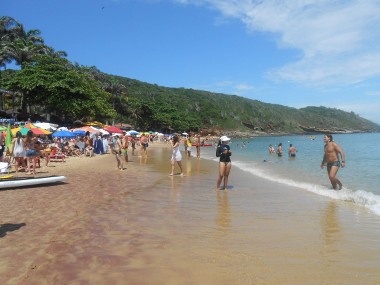 |
And finally it was time for the biggie - the fabled city of Rio de Janeiro. I admit it -was- an amazing sight as the AIDACara sailed past the city with its famous landmarks - Sugar Loaf Mountain on the left side, Cristo Redentor lurking on the Corcovado in the background - on her way to the harbour just as the sun was rising.

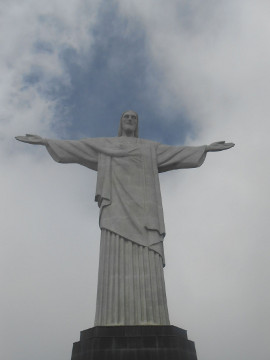 Although I had been a bit worried about Rio's reputation for street crime, I simply couldn't face the idea of joining the sheeple in this wonderful town, so instead we caught a cab at the port that took us to the Estação Cosmo Velho, where the touristy trams depart for the Corcovado, passing what's left of Rio's last bit of rainforest on the way.
Although I had been a bit worried about Rio's reputation for street crime, I simply couldn't face the idea of joining the sheeple in this wonderful town, so instead we caught a cab at the port that took us to the Estação Cosmo Velho, where the touristy trams depart for the Corcovado, passing what's left of Rio's last bit of rainforest on the way. The morning then turned into an epic struggle with Christ indeed, as fog suddenly drew up and engulfed the whole Corcovado, so that we couldn't even see the full Cristo statue, much less the fabulous view across Rio and its beaches. We hung around for some time and finally the fog cleared enough to at least make the statue fully visible and offer a few glimpses of Rio underneath, but unfortunately this is all I can offer by way of the famous view:
 |
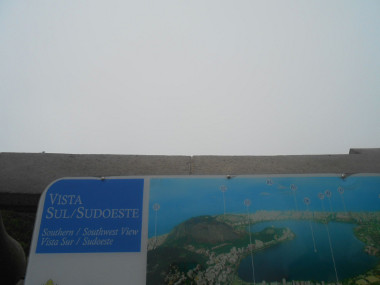 |
Not wanting to waste our whole day waiting literally for better weather, we headed downhill again and simply - despite AIDA's warning against using Rio's oh so dangerous public transport -hopped onto a public bus that took to us to Leblon beach for all of 2.75 Reais. From there we walked along Rio's famous beaches - Leblon, Ipanema and finally the Copacabana, where we crashed into sunloungers to chill for a few hours, soak up the sun, watch the action and swim in the cool Atlantic (and have another Açai smoothie).
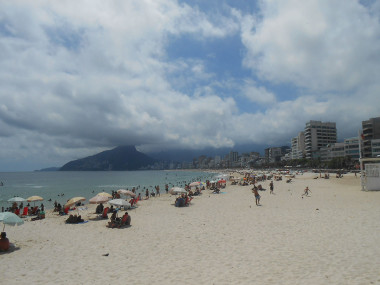 |
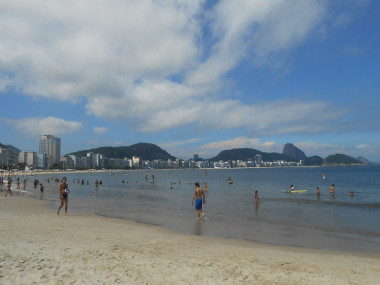 |
Finally we explored the shopping streets of Ipanema and watched the sunset from Arpoador with a cold beer in hand, before grabbing a cab that took us back to the cruise terminal in the Centro - with a nice drive across town all along the Copacabana and the "older" beaches of Botafogo and Flamengo. A great day indeed (well, except the lack of sight from Corcovado) and I never felt unsafe for a second.
 Although I did feel just a tiny bit smug when some guy at breakfast whined about having his expensive camera nicked on the beaches - apparently the precautions were rather useful after all! We had another morning in Rio, which we used to walk around the Centro, the historic heart of Rio with gorgeous old churches, palatial buildings and a stop at the Confeitaria Colombo, pretty much a tourist trap like the Cafe Tortoni in Buenos Aires, but nonetheless a lovely Art Deco coffee house harking back to Rio's grand old time as capital of young independent Brazil.
Although I did feel just a tiny bit smug when some guy at breakfast whined about having his expensive camera nicked on the beaches - apparently the precautions were rather useful after all! We had another morning in Rio, which we used to walk around the Centro, the historic heart of Rio with gorgeous old churches, palatial buildings and a stop at the Confeitaria Colombo, pretty much a tourist trap like the Cafe Tortoni in Buenos Aires, but nonetheless a lovely Art Deco coffee house harking back to Rio's grand old time as capital of young independent Brazil. Then it was a last afternoon on the sun deck as the AIDA left port and sailed past Rio - the Sugar Loaf mountain, the beaches and the Cristo of course. And somehow I'm quite sure I haven't been here for the last time.
The cruise ended in Santos the next morning for some reason - I don't know why it didn't just end in Rio where people could have caught planes home too since basically all we could do was take a bus onwards to São Paulo and head to the airport with not enough time really to at least explore the mega-city as well. Not that São Paulo looked all that attractive from what I saw - just a sea of high-rises with the odd old colonial building tucked into some corners.
Overall, admittedly, I didn't enjoy this cruise as much as the first one - I had much rather spent the evenings in the cities or watching the sunset from lovely beach bars, explore further and generally feel better connected to the country I'm visiting instead of having to return to the German bubble of the ship every day. I'm quite sure I will eventually return to Rio as well as explore other areas of Brazil - but when it comes to cruises, I don't know if I will do more beyond the one already booked (but mercifully not on a German boat at least).
Copyright © All Rights Reserved